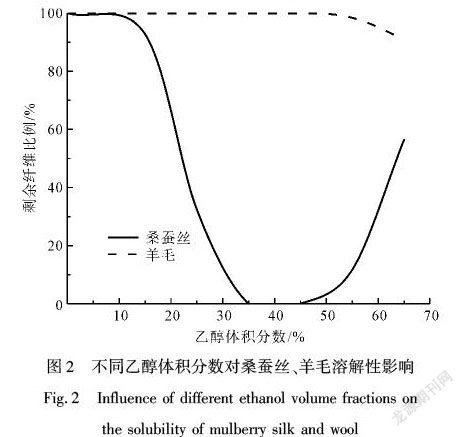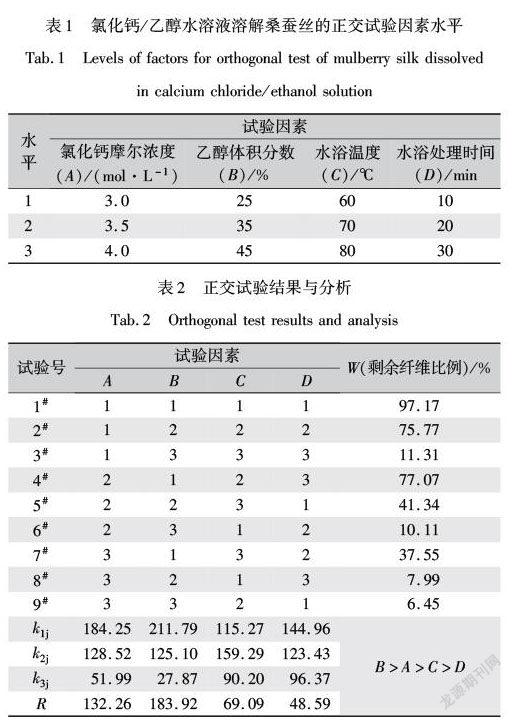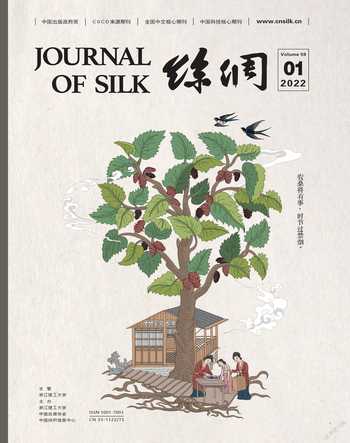氯化钙/乙醇法定量分析桑蚕丝/羊毛混纺织物
俞昌朝 周兆懿





摘要: 本文采用氯化钙/乙醇水溶液去除桑蚕丝/羊毛混纺织物中的桑蚕丝纤维,以对桑蚕丝/羊毛混纺织物的纤维含量进行定量分析,研究了氯化钙/乙醇水溶液中氯化钙摩尔浓度、水浴温度、乙醇体积分数、水浴处理时间等条件对桑蚕丝、羊毛溶解性能的影响。结果表明,4 mol/L的氯化钙和乙醇体积分数为45%的水溶液在80 ℃水浴中处理30 min,可作为桑蚕丝/羊毛混纺织物纤维含量定量分析的最佳溶解条件,并且对羊毛纤维的损伤较小。
关键词: 桑蚕丝;羊毛;混纺织物;氯化钙;定量分析
中图分类号: TS107.6 文献标志码: A 文章编号: 1001-7003(2022)01-0025-06
引用页码: 011104DOI: 10.3969/j.issn.1001-7003.2022.01.004
桑蚕丝与羊毛的混纺织物具有手感顺滑、弹性优良和轻柔舒适等特点,其中羊毛与桑蚕丝的比例一直被商家和消费者视为重要的性能指标,因此桑蚕丝/羊毛混纺织物中各纖维含量检测结果的准确性非常重要。羊毛纤维主要由角蛋白构成,含量占到99%,其成分主要是氨基酸通过肽键相连而成的多缩氨基酸,这也构成了羊毛角蛋白分子的主链[1]。羊毛角蛋白的理化性质并不是由这些主链决定的,而是取决于它的侧链种类和侧链之间的交联情况,这些交联情况有氢键、二硫键和范德华力等,这些交联结构容易受到强酸、强碱和氧化还原反应等破坏,但在一般的无机盐水溶液中表现比较稳定[1-2]。桑蚕丝与羊毛同为蛋白质纤维,但其结构和理化性能不尽相同。桑蚕丝主要由丝素和丝胶组成[3-4],丝素是桑蚕丝的主要组成部分,含量占到70%~80%。纺织品中的桑蚕丝一般都是经过脱胶的丝素,丝素容易溶于高浓度的中性盐溶液[5-6]。
目前,桑蚕丝/羊毛混纺织物中各纤维含量的检测方法一般为75%硫酸法、35%盐酸法和甲酸/氯化锌法[7-9]。75%硫酸法是目前较为常用的定量分析方法,但是常温下75%的硫酸溶液黏度较大,很难快速充分渗透到纤维内部,导致桑蚕丝无法完全溶解,同时实际检测过程中试样带有的染料会与丝纤维水解蛋白相结合,增加了检测液的黏稠度,造成检测结果与实际结果产生较大差异。35%浓盐酸溶液和甲酸/氯化锌溶液虽然渗透性比75%硫酸溶液好,但是两种试剂易挥发、刺激性大,劳动防护要求高,并且35%盐酸溶液对羊毛损伤较大,修正系数d值(不溶纤维的质量变化修正系数,即原质量/处理后质量)大于1.05;甲酸/氯化锌溶液对深色混纺织物同样存在无法彻底溶解的问题[10-12]。因此,如何更简便、安全和快速地分离桑蚕丝与羊毛组分成为提高检测效率和准确性的关键。
文献[13]报道,桑蚕丝在钙的氯化盐的浓溶液中会发生无限膨润,并且该盐溶液中的钙离子能够破坏丝素蛋白中起稳定β折叠结构作用的氢键和范德华力,使桑蚕丝进一步无限膨润最终至完全溶解[14]。因此,本文采用氯化钙/乙醇水溶液代替GB/T 2910.18—2009《纺织品定量化学分析第18部分:蚕丝与羊毛或其他动物毛纤维的混合物(硫酸法)》中的75%硫酸溶液,在适宜的条件下分离桑蚕丝与羊毛,从而改进桑蚕丝与羊毛混纺产品各纤维含量的检测方法。
1 试 验
1.1 材料与设备
试样:桑蚕丝标准贴衬织物,平方米质量(60±3) g/m2;羊毛标准贴衬织物,平方米质量(125±5) g/m2,上述标准贴衬织物均符合GB/T 7568—2008《纺织品色牢度试验标准贴衬织物》。
试剂:氯化钙、无水乙醇、硫酸(国药化学试剂有限公司),均为分析纯。
仪器:DKZ-2型恒温振荡水浴槽(上海精宏实验有限公司),ML-204T型分析天平(梅特勒托利多国际贸易(上海)有限公司),UF160型恒温烘箱(美国莫尔特贸易有限公司)。
1.2 步骤与结果计算
将氯化钙加入去离子水中溶解,待冷却后加入无水乙醇,配制成一定比例的氯化钙/乙醇水溶液。将桑蚕丝和羊毛标准贴衬织物分别拆成纱线,按照一定比例混合烘至恒重后放入具塞三角烧瓶,按1 ︰ 100(m/m)加入预热的氯化钙/乙醇水溶液,水浴振荡一定时间。用玻璃砂芯坩埚(已称量)过滤,同温下先后用氯化钙/乙醇水溶液和水清洗至中性,洗后用真空抽吸排液。将残留物烘干、冷却、称重,结果计算和表示参照GB/T 2910.1—2009《纺织品定量化学分析第1部分:试验通则》进行。
2 结果与分析
2.1 氯化钙摩尔浓度对桑蚕丝、羊毛溶解性的影响
氯化钙对桑蚕丝的溶解属于膨润溶解,当氯化钙水溶液中的钙离子渗透到丝素纤维的内部,破坏分子链之间的氢键和范德华力,增加了溶液的极性,让丝素大分子肽链分离,此时纤维会发生溶胀,钙离子与桑蚕丝氨基酸中的丝氨酸、酪氨酸侧链羟基进行配位形成络合物,促使丝素蛋白纤维膨润而溶解[15]。
本文参照了FZ/T 40005—2009《桑/柞产品中桑蚕丝含量的测定化学法》中的测试条件,乙醇体积分数为45%,水浴温度为80 ℃,水浴处理时间设为30 min,试验中氯化钙的摩尔浓度为1.0~4.5 mol/L,结果如图1所示。
由图1可知,氯化钙摩尔浓度在1 mol/L和2 mol/L时,桑蚕丝基本没有溶解。这说明低浓度氯化钙溶液中的钙离子不能充分地破坏丝素纤维分子间的氢键和范德华力。随着氯化钙摩尔浓度增加,溶液中钙离子浓度增加,桑蚕丝开始加速溶解,当氯化钙摩尔浓度超过3.5 mol/L后,桑蚕丝能够完全溶解。另外,氯化钙摩尔浓度的增加基本未造成羊毛纤维质量的损失。因此,氯化钙摩尔浓度为3.5 mol/L时桑蚕丝的溶解率可达到较高水平,同时又能保证羊毛在试验中不被溶解。
2.2 乙醇体积分数对桑蚕丝、羊毛溶解性的影响
文献[16-18]报道,用氯化钙水溶液作为溶剂,丝素的溶解度会在加入一元醇(甲醇或乙醇)后急剧增大。将氯化钙摩尔浓度控制在3.5 mol/L,水浴温度为80 ℃,水浴处理时间为30 min不变,考察乙醇体积分数(v/v)从0上升到65%的过程中桑蚕丝和羊毛纤维溶解性能的变化,结果如图2所示。
由图2可知,随着氯化钙/乙醇水溶液中乙醇体积分数的增加,桑蚕丝的溶解性显著增强。当溶液中不含乙醇时,桑蚕丝在30 min之内基本不溶解,这与陈佳弘等[19]的研究结果一致。乙醇分子的渗透能力要强于水分子,所以加入乙醇可以提升钙离子向丝素纤维内部渗透的速率,同时乙醇的添加能够降低溶液的表面张力,提高氯化钙的渗透能力,加速了丝素蛋白纤维的溶胀和溶解[20]。但当乙醇体积分数超过60%时,氯化钙达到饱和以致无法完全溶解,因此过多地增加乙醇将使溶液中钙离子浓度降低,从而降低了桑蚕丝在溶液中的溶解性。试验中还发现,羊毛在乙醇体积分数过高时会出现明显损伤现象,因此综合考虑乙醇体积分数设为35%较为合适。
2.3 水浴温度对桑蚕丝、羊毛溶解性的影响
设氯化钙摩尔浓度为3.5 mol/L,乙醇体积分数为35%,水浴处理时间为30 min,在不同水浴温度(40~90 ℃)下,研究桑蚕丝与羊毛的溶解性能,结果如图3所示。
由图3可知,在氯化钙/乙醇水溶液中,随着水浴温度升高,桑蚕丝的溶解性增大。温度在70 ℃及以上时,溶液呈现透明澄清状,即桑蚕丝充分溶解。而羊毛纤维在氯化钙/乙醇水溶液中的溶解性随温度的提升无显著变化,即羊毛基本不溶于氯化钙/乙醇水溶液。水浴温度升高,分子热运动加快,提高了丝素膨润溶解的速度[21-22]。因此,水浴温度在70 ℃及以上能够保证桑蚕丝充分溶解于氯化钙/乙醇水溶液中,且不损伤羊毛纤维。
2.4 水浴处理时间对桑蚕丝、羊毛溶解性的影响
在氯化钙摩尔浓度为3.5 mol/L,乙醇体积分数为35%,水浴温度为70 ℃条件下,研究不同水浴处理时间(5~40 min)对桑蚕丝与羊毛的溶解性的影响,结果如图4所示。
由图4可知,处理时间在5 min以内时,桑蚕丝纤维的溶解性较小;处理时间延长至10 min时,桑蚕丝的溶解性随处理时间的增加而快速增加;再延长处理时间,溶解性趋于缓和[23],在20 min之内基本溶解完全。因此,结合羊毛的溶解性,水浴处理时间宜设置为20 min。
2.5 氯化钙/乙醇水溶液中各溶解条件对桑蚕丝溶解性的综合影响 选取氯化钙摩尔浓度,乙醇体积分数,水浴温度和水浴处理时间为因素设计正交试验。以剩余纤维比例为评价指标,研究各溶解因素在氯化钙/乙醇水溶液中对桑蚕丝溶解性能的综合影响,优选最佳的溶解条件。因素水平如表1所示,结果与分析如表2所示。
由表2的影响因子测试结果(B>A>C>D)可知,乙醇体积分数对桑蚕丝的溶解性影响最大,水浴处理时间相较于其他因素影响最小。通过正交试验各因素试验指标和均值(k)分析得出,最优组合为B3A3C3D3,对应的溶解条件为45%乙醇体积分数的水溶液作为溶剂,4 mol/L氯化钙,80 ℃水浴,时间30 min。由表2还可以发现,9组试验条件的溶解结果中,桑蚕丝纤维均未完全溶解,将最优组合用来溶解桑蚕丝纤维,发现此条件下能将桑蚕丝完全溶解,满足混合物定量分析的基本条件。
2.6 氯化钙/乙醇水溶液对桑蚕丝/羊毛混纺织物定量分析结果的影响 为了进一步验证氯化钙/乙醇水溶液定量分析方法的准确性,本文使用桑蚕丝和羊毛标准贴衬制备了几组不同比例的桑蚕丝/羊毛混纺织物,分别使用氯化钙/乙醇水溶液与GB/T 2910.18—2009中规定的75%硫酸法在各自最佳或者规定反应条件下进行比较试验,结果如表3所示。
由表3可知,采用75%硫酸法的试验结果偏差较大。采用摩尔浓度为4 mol/L氯化钙、乙醇体积分数为45%的水溶液作为溶剂,80 ℃水浴,处理时间30 min能够仅溶解桑蚕丝/羊毛混纺织物中的桑蚕丝纤维。采用氯化钙/乙醇水溶液法除去桑蚕丝,剩余羊毛的实测含量与理论值较为接近,经计算羊毛d值为0.998,接近于1.0,而75%硫酸法中对羊毛规定的d值为0.985,说明氯化钙/乙醇水溶液法对羊毛纤维损伤较小。
3 结 论
本文采用氯化钙/乙醇水溶液法,研究了不同试验条件下桑蚕丝与羊毛的分离情况,从而改进桑蚕丝与羊毛混纺产品纤维含量的检测方法。研究表明:
1) 氯化钙水溶液中添加适量的乙醇能够显著提高其对桑蚕丝的溶解性,且不损伤羊毛纤维。
2) 氯化钙/乙醇水溶液能够对桑蚕丝/羊毛混纺织物进行准确的纤维含量分析,其最优方案为氯化钙摩尔浓度4.0 mol/L,乙醇体积分数45%,水浴温度80 ℃,水浴處理时间30 min。
参考文献:
[1]徐恒星. 羊毛角蛋白的提取及其应用[D]. 上海: 东华大学, 2011.
XU Hengxing. Wool Keratin Extraction and Its Application[D]. Shanghai: Donghua University, 2011.
[2]张明月. 羊毛角蛋白/丝胶/水性聚氨酯共混膜的制备及对重金属吸附研究[D]. 上海: 东华大学, 2020.
ZHANG Mingyue. Preparation of Wool Keratin/Sericin/Waterborne Polyurethane Composite Films and Its Adsorption of Heavy Metals[D]. Shanghai: Donghua University, 2020.
[3]王宗乾, 楊海伟, 王邓峰. 脱胶对蚕丝纤维的溶解及丝素蛋白性能的影响[J]. 纺织学报, 2018, 39(4): 69-76.
WANG Zongqian, YANG Haiwei, WANG Dengfeng. Influence of degumming on solution of silk fiber and property of fibroin[J]. Journal of Textile Research, 2018, 39(4): 69-76.
[4]ARAMWIT P, SIRITIENTONG T, SRICHANA T. Potential applications of silk sericin, a natural protein from textile industry by-products[J]. Waste Management & Resaech: The Journal for a Sustainable Circular Economy, 2011, 30(3): 217-224.
[5]VEPARI C, KAPLAN D L. Silk as a biomaterial[J]. Progress in Polymer Science, 2007, 32(8): 991-1007.
[6]王鹏, 左保齐. 不同盐/甲酸溶解体系下丝素膜的制备及性能表征[J]. 丝绸, 2016, 53(7): 18-22.
WANG Peng, ZUO Baoqi. Preparation of silk fibroin films in different salt/formic acid dissolution system and its property characterization[J]. Journal of Silk, 2016, 53(7): 18-22.
[7]何艳芬, 曹颖. 羊毛/桑蚕丝混纺织物定量分析方法的研究与探讨[J]. 山东纺织科技, 2013, 54(1): 27-29.
HE Yanfen, CAO Ying. Research and discussion on quantitative analysis method of wool/silk blended fabric[J]. Shandong Textile Science & Technology, 2013, 54(1): 27-29.
[8]胡凇月, 葛晓青. 羊毛与桑蚕丝混纺织物定量分析方法的研究[J]. 针织工业, 2016(5): 71-74.
HU Songyue, GE Xiaoqing. Quantitative methods for wool and mulberry silk blended fabric[J]. Knitting Industries, 2016(5): 71-74.
[9]郑少明, 赖祥辉. 甲酸/氯化锌法定量分析羊毛/桑蚕丝混纺产品[J]. 中国纤检, 2014(13): 74-75.
ZHENG Shaoming, LAI Xianghui. The quantitative analysis of wool/silk blend fabric by formic acid and zinc chloride[J]. China Fiber Inspection, 2014(13): 74-75.
[10]钱蕾. 甲酸/氯化锌法对深色桑蚕丝/羊毛混纺产品的定量化学分析研究[J]. 中国纤检, 2014(1): 102-104.
QIAN Lei. The research to silk/wool blended products quantitative chemical analysis use formic acid/zinc chloride method[J]. China Fiber Inspection, 2014(1): 102-104.
[11]茅沈杰, 王佳云, 杨宝. 几种羊毛/桑蚕丝定量方法的对比分析[J]. 纺织报告, 2014(10): 70-72.
MAO Shenjie, WANG Jiayun, YANG Bao. Analysis and comparison of several wool/silk quantitative methods[J]. Textile Reports, 2014(10): 70-72.
[12]董金俊, 许恒哲, 卢站柱. 用不同方法定量分析羊毛和桑蚕丝二组份织物[J]. 现代纺织技术, 2019, 27(1): 42-46.
DONG Jinjun, XU Hengzhe, LU Zhanzhu. Quantitative analysis of two component fabrics of wool and silk by different methods[J]. Advanced Textile Technology, 2019, 27(1): 42-46.
[13]吴惠英. 再生丝素蛋白纤维及其在生物医用材料中的研究进展[J]. 丝绸, 2017, 54(3): 6-12.
WU Huiying. Research progress in regenerated silk fibroin fiber and its application in biomedical materials[J]. Journal of Silk, 2017, 54(3): 6-12.
[14]倪莉, 王璋, 姚文华, 等. 丝素蛋白结构的研究1探讨氯化钙溶液溶解丝素的机理[J]. 中国食品学报, 2001(1): 12-18.
NI Li, WANG Zhang, YAO Wenhua, et al. Study on the structure of silk fibroin 1. Mechanism of dissolving silk fibroin with CaCl2[J]. Journal of Chinese Institute of Food Science & Technology, 2001(1): 12-18.
[15]施丽君. 再生丝素蛋白基薄膜的制备及性能研究[D]. 上海: 上海交通大学, 2014.
SHI Lijun. Preparation and Properties of the Regenerated Silk Fibroin-Based Films[D]. Shanghai: Shanghai Jiao Tong University, 2014.
[16]王建南, 季小琴, 裔洪根. 氯化钙微溶解过程中桑蚕丝的晶态结构研究[J]. 江苏蚕业, 2004(1): 6-8.
WANG Jiannan, JI Xiaoqin, YI Honggen. Crystal structure of silk in microdissolution of calcium chloride[J]. Jiangsu Sericulture, 2004(1): 6-8.
[17]王建南, 陈宇岳, 盛家镛, 等. 真丝在氯化钙溶液中的分纤举动与力学性能[J]. 丝绸, 2002(2): 8-10.
WANG Jiannan, CHEN Yuyue, SHENG Jiayong, et al. The separating behavior and mechanical properties of real silk in calcium chloride solution[J]. Journal of Silk, 2002(2): 8-10.
[18]肖露, 杨旭超, 余卫华, 等. 桑/柞蚕丝不同溶解体系再生丝素蛋白性能研究[J]. 纺织科技进展, 2017(11): 13-16.
XIAO Lu, YANG Xuchao, YU Weihua, et al. Properties of regenerated silk fibroin from mulberry/tussah silk in different solvent systems[J]. Progress in Textile Science and Technology, 2017(11): 13-16.
[19]陈佳弘, 江虹锐, 余炼, 等. 丝素蛋白在氯化钙-乙醇-水体系中的溶解行为及其结构的变化[J]. 现代食品科技, 2017, 33(9): 37-45.
CHEN Jiahong, JIANG Hongrui, YU Lian, et al. Dissolution behavior and structural changes of silk fibroin in calcium chloride-ethanol-water solvent systems[J]. Modern Food Science and Technology, 2017, 33(9): 37-45.
[20]裔洪根, 王建南. 氯化钙微溶条件下桑蚕丝的形态结构研究[J]. 四川蚕业, 2002(4): 17-20.
YI Honggen, WANG Jiannan. Study on the morphological structure of mulberry silk under calcium chloride solution[J]. Sichuan Canye, 2002(4): 17-20.
[21]李玲玲, 周伟, 代方银, 等. 不同钙-醇溶解体系丝素蛋白的制备及表征研究[J]. 中国生物工程杂志, 2012, 32(4): 28-32.
LI Lingling, ZHOU Wei, DAI Fangyin, et al. Preparation and characterization of silk fibroin treated with different calcium-alcohol solution[J]. China Biotechnology, 2012, 32(4): 28-32.
[22]劉明. FTIR对丝素蛋白构象的研究[D]. 杭州: 浙江大学, 2006.
LIU Ming. Studies on the Conformation of Silk Fibroin by FTIR[D]. Hangzhou: Zhejiang University, 2006.
[23]董文秀. 丝蛋白质结构变化与表面活性性能关系的研究[D]. 柳州: 广西科技大学, 2015.
Abstract: The blended fabric of mulberry silk and wool has the characteristics of smooth hand feeling, excellent elasticity, softness and comfort. On account of the expensive price of mulberry silk and wool blended fabric, the ratio between both has always been regarded as an important performance index by merchants and consumers. In recent years, great discrepancy between the fiber content of silk/wool blended fabric and the label and even disqualification have been detected in quality supervision and random checking, causing considerable troubles to consumers. Therefore, the accuracy of fiber content detection results in silk/wool blended fabric is very important. At present, the quantitative analysis methods used in the laboratory has some defects in actual operations, leading to the deviation of the test results.
Both mulberry silk and wool are protein fibers, which can hardly be distinguished by common acid and alkali solvents due to their similar acid and alkali resistance, causing great difficulties in quantitative analysis of silk/wool blended fabric. Studies have found that mulberry silk and wool are different in chemical composition and microstructure. Literature reports show that mulberry silk will swell indefinitely in a chloride concentrated solution of calcium, and the calcium ions in the salt solution will destroy hydrogen bond and van der Waals force that can stabilize β-folding structure in the silk fibroin, so that the mulberry silk further swell until it is completely dissolved. On the other hand, the performance of wool fiber is very stable in the general inorganic salt solutions.
Therefore, in this study, the calcium chloride/ethanol solution was used to replace the strong acid reagent commonly used in the laboratory, the mulberry silk and the wool was separated under appropriate conditions, thereby improving the methods of detecting fiber content in silk/wool blended fabric products. The study discussed the dissolution mechanism of silk/wool blended fabric with calcium chloride/ethanol solution, investigated the influence of the concentration of calcium chloride, water bath temperature, ethanol volume fraction and water bath treatment time on the dissolving performance of mulberry silk and wool. Finally, the optimal dissolution solution was established to quantitatively analyze the fiber content of silk/wool blended fabric.
At present, the solvents used in the quantitative analysis standards for fiber content in silk/wool or some other hair fibers mixtures blended fabric are strong acid reagents, which causes great damage to hair fibers in the blended fabric, enhances operation difficulties, and easily leads to the deviation of test results. A new salt-water reagent adopted in this project as the substitute of the conventional strong acid reagent can reduce the damage to hair fibers during the test and improve the accuracy of test results.
The results show that the optimal dissolution condition for quantitative analysis of silk/wool blended fabric is: 30 min water bath in 4 mol/L aqueous solution with calcium chloride/ethyl alcohol volume fraction of 45% at 80 ℃, and the test method has light damage to wool fiber.
This project has improved the method of quantitative analysis on the fiber content of silk/wool blended fabric, improving the accuracy of the test data and helping test personnel solve the difficulties in daily inspection work. In addition, it can help market regulators crack down on deceptive and fraudulent sales behavior, therefore helping the consumers buy related textile.
Key words: mulberry silk; wool; blended fabric; calcium chloride; quantitative analysis

